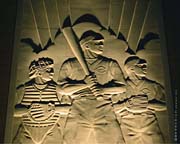

The wall design, titled “Spirit of Baseball,†is of a young boy holding a bat, and three baseball players - an outfielder, a catcher and a batter. It is referred to as a bas-relief, a sculpture with images that project out slightly from the background. With the format of the design being three-dimensional, the scene has a bit more character to it.
“The bas-relief is meant as a civic gesture to the people of Cincinnati and to baseball in general,†said project designer/manager Ray Berberich of Berberich Design Inc. in Cincinnati, OH. “The goal of the design was meant to inspire young people, and have older patrons reflect on the past.†The dedication plaque located just under the bas-relief sums it up as it reads, “Dedicated to the Big Leaguer in all of us. Follow your dreams, never give up,†written by Berberich.
The original design was illustrated by Mark Riedy and then made into a 2- x 5-foot scaled sculpture carved by Todd Myers and Paul Brooke. This smaller sculpture served as the model for the large-scale stone carving. “The inspiration for this design came directly from the Cincinnati Union Terminal building completed in 1931,†explained the designer. “Now home for the several museums, this building was one of the last great Art Deco train stations built in the U.S. The building is a half sphere and made completely of limestone - making limestone the only consideration for the bas-relief. The entry facade of Union Terminal has two large bas-relief sculptures that flank each side of the main entry.â€
After the preliminary design details and the choice of the stone were complete, the steps to convert the ideas into the 20- x 50-foot limestone bas-relief began. “Panels of Indiana limestone [measuring 76 x 59 inches] were chosen, based on the final design layout and available block size from the quarry in Bloomington, IN,†explained Berberich. “This was the largest panel we were able to work with.â€
Finding a place to fabricate such a large structure posed a bit of a challenge for supplier/fabricator Mees Distributors, Inc. “Overall scale of the project was 20 x 50 feet, and we needed a large enough work space dedicated to the project for about 10 months,†said shop foreman, Steve Engel of Mees Distributors Inc. “Even with the shop size we have, we needed to clear a spot to work - where it wouldn't be disturbed in that amount of time. Unfortunately, we didn't have the ability to bring more staff on for this particular project, so it involved working a lot of overtime in order to remove some stock of slabs - all that material was condensed and relocated.â€
After a suitable area was cleared, the slabs were ready to be fabricated with a three-axis CNC mill. “This type of carving is similar to how automobile parts are carved,†explained Engel. “As [the working unit] goes up and down and left to right, it makes very small passes to put a nice smooth finish on it.â€
The stone was put through step-by-step fabricating process. “With a saw blade, each slab on the CNC was first roughed within a 1â„2 inch of the final surface,†said Engel. “The final cut was with a 3â„4-inch ball end mill machine. After each slab was milled, the bas-relief was ready to be assembled.â€
The next step was to install the limestone structure to the exterior of the stadium. “Each panel was independently hung so it was not as if it were one big stacked unit,†stated Engel. “It was actually supported by four very large steel columns on the backside. Each row is supported by 3â„8-inch stainless steel pins and fasteners.†The stainless steel clips and bolts that fastened the limestone to the ballpark were from Spring Grove Sheet Metal, according to installer Joe Albert of Siemering Tile Co., Inc. in Cincinnati, OH. Caulking, from Pecora Corp., was placed between the joints and the stone for additional support.
The size of the mural was quite big, but it really had no bearing on how long or how many workers were installing the bas-relief. “We had two people installing the stone along with a 75-ton crane,†said Albert. “Once you get over 300 or 400 pounds of stone, you need a crane anyway, so it really doesn't matter about the size of the project.â€
Since the project was installed in the cold months of January and February, it wound up taking longer than expected. The limestone was installed over a two-month period of time, but the workers only installed the stone for a total of four weeks, according to Albert. “The temperature got down in the teens, and handling the nuts and bolts became very difficult with gloves on, and it was too cold handling them without gloves.†There was a lot of down time due to the cold conditions, therefore it wound up slightly delaying the completion, according to the installer.
One element that was discussed after completing the installation was whether to seal the limestone or leave it exposed. The decision was made not to seal it because of the amount of moisture embedded in the stone, but it may be an option for the future, according to Engel. “There were some pros and cons for the argument, but the decision was given to the engineer Mike Lewis at Facade Forensics,†said Engel. “Mike said, 'We shouldn't seal it because the project was finished in the winter.' We used a lot of water with the panels, which made them purely saturated. It was way too cold for them to totally dry out. It does face due west, so in the summer time it is hit fully by the sun. Putting a sealer on it [during the winter] would may be ineffective.â€